Deciding to book a winter skills course is a matter of safety in the hills. You definitely don’t want to be the one who’s on the wrong end of a call to mountain rescue. Most rescue callouts stem from navigational error, but not being prepared for the wild conditions can be a contributing factor. The Cairngorms offer some of the most consistent full-on winter conditions for the aspiring winter walker. Learning here under the expert tutelage of experienced, qualified guides is an experience which will stand you in good stead for the rest of your life.
Andy Bateman of Scot Mountain Holidays gives you some of his experience as a result of 20 years of coaching winter skills and navigation in the Cairngorms.
As the first snows arrive on the mountains many hang up their hiking boots. They wait until spring to go out again. Yet if you continue to head out throughout the winter, you could have some sensational days out. Cold air holds less moisture so on a clear day the views go in forever, the horizon crystal clear. The wonderful Jack Frost creation that is rime ice marks the air flow aroundevery stone and boulder. This is all the result of freezing hill fog on the wind. Older lying snow is scoured by the wind to produce the wonderful flutings. These are called Sustrugi. All these natural sculptures interplay with the soft light of a winters day.
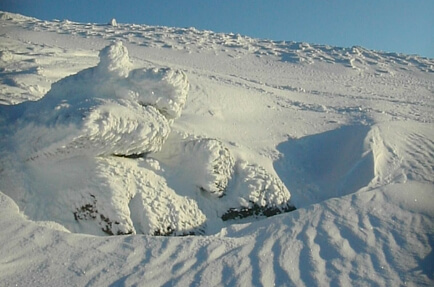
All kinds of natural sculptures appear in the hills during winter
Photo caption & credit: The snow turns the Cairngorm plateau into a place of beauty (taken by Andy Bateman, Scot Mountain Holidays)
Of course this environment isn’t without its hazards. It is no place for the ill prepared. Once trained in the essential winter skills there’s a very special sense of privilege. This comes from being able to exist confidently and comfortably in this hostile yet pristine and beautiful winter wonderland.
The conditions on the British mountains in winter are often as varied as the weather that’s created them. You need a good variety of skills at your disposal. Your winter boot is just as much a tool as your axe or crampons. It needs to be of adequate stiffness. On steep snow and ice covered ground good footwork is the watchword. Your approach should be from the perspective of prevention rather than cure. You should try step kicking and cutting or crampon techniques before resoring to the techniques of self-belay and self-arrest.
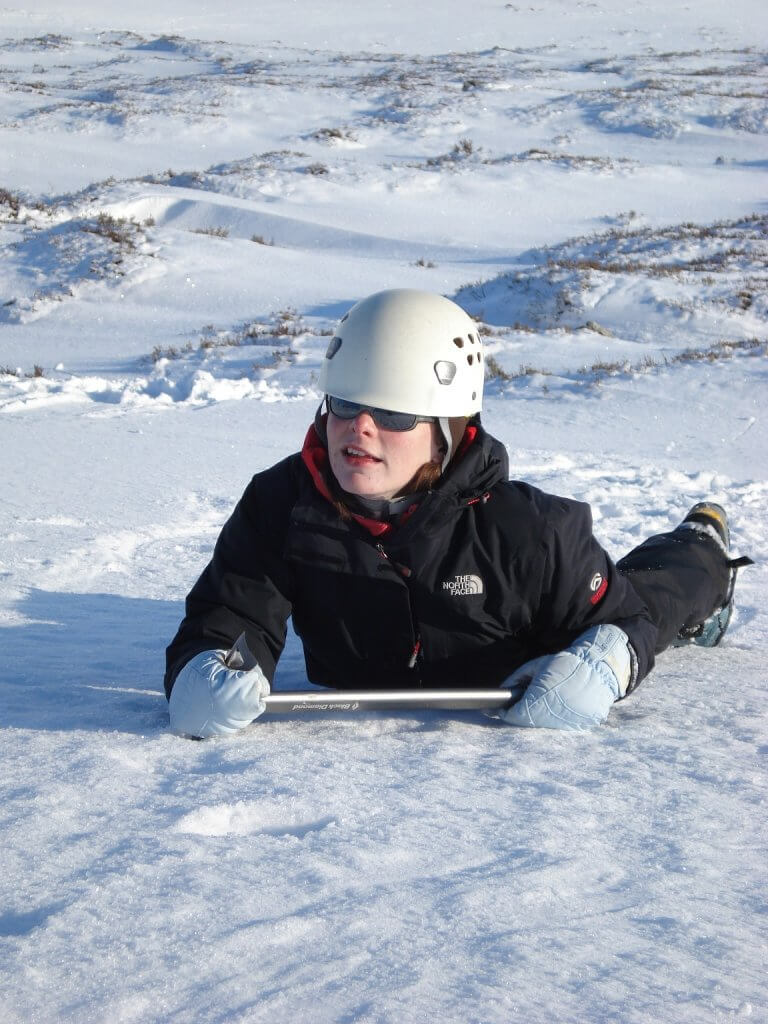
Self-arresting on a winter skills course in the Cairngorms
Photo caption: Practising winter skills in the Cairngorms – the classic feet first on your front self-arrest (5 day winter skills course with Scot Mountain Holidays)
Knowing though, that when all else fails, you can confidently and quickly stop a sliding fall, with or without an axe is a fantastic fillet to your confidence. Some of the self-arrest techniques are straight forward enough but others are not; sliding head first on your back is a case in point. Understanding the body position that is required for the forces of gravity to work in your favour is all important; in one fluent move you flip you’re yourself onto your front whilst swinging your legs beneath you – easy when the dynamics and body posture have been clearly explained.
For many the step up in navigation standard that’s demanded by the winter mountains is often the biggest challenge of all. Here the right approach is crucial and accuracy comes in a number of forms and levels. Being totally reliant on the absolute accuracy in your compass bearings and dead reckoning techniques (timing and pacing) has been the unravelling of many an aspiring Mountain Leader. In the often flat light conditions of winter, contour interpretation becomes even more imperative yet perceived poor visibility encourages folk to abandon this vital skill.
Many good mountain navigation techniques come in under the heading of “error management”. Some of these techniques will be familiar to the experienced: aiming off, collection features and attach points but these are just a few of the techniques that can be used to make life easier in the winter mountains. Good winter navigation skills could be the difference between stay on safe ground and straying onto that that is prone to a slide.
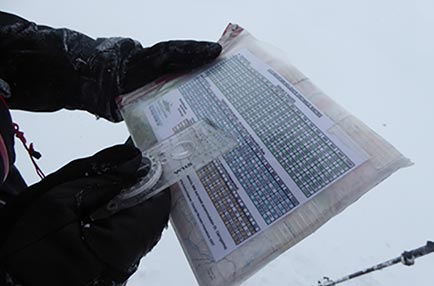
Highly skilled micro-navigation in practice
Photo Caption: Winter micro-navigation using Andy’s patented timing and pacing chart (winter navigation course with Scot Mountain Holidays)
Evaluating Avalanche hazard is another subject difficult to get a handle on. There are though pertinent points that, when borne in mind at the planning stage, can already be starting to reduce your chances of ever being caught in an avalanche. Yes, you could start avalanche hazard evaluation in the summer months long before the snow has arrived! It is of course though, an ongoing process of monitoring right through to the end of the trip and not least of which is viewing and understanding the avalanche forecast.
If you would like to discuss any of the points Andy raises in his article, please don’t hesitate to call him on 01479 831 331
Remember that Andy’s experience has been gained over 17 years of living and working in the Cairngorms. He aims to give you as much knowledge as he can while you’re here but it’s only in practicing the skills he introduces that you’ll gain proficiency yourself.
Which winter boots to choose for winter skills and winter hiking?
How to choose a walking ice axe for a winter skills course?
Why go walking in winter in Scotland?
How do I prepare for a winter skills course?
Andy Bateman of Scot Mountain Holidays leads at least 3 commercial snow hole expeditions in the Cairngorms Mountains every winter season. He has introduced scores of people to the magic of the winter season. He is also an expert at the skill of building a snow hole for a drip free night out in the mountains. To see what snowholing expedition experience is like for the customer check out our video on YouTube:
Seasonal temperatures on the high hills in Scotland are never as low as those in the valleys. You need to take this into consideration when planning to snowhole. Here in Boat of Garten we get temperatures of around -20oC. The lowest ever recorded temperature on the summit of Cairngorm is -16.5oC. Cold temperatures in the valley always occur under cold settled conditions. This is when the cold air drains off the mountain. The cold air then pools in the bottom of the valley. This means that in the Cairngorms the temperatures are never as low as in Norway.
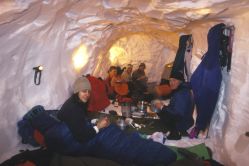
Enjoying an evening meal in the luxury palace makes the snowholing expedition unforgettable!
In Norway, you need to capture the warm air. Most people learn to build snow caves in Norway. They learn to create features which capture the warm air inside the shelter. In Scotland, however, you are operating much close to the melting temperature of snow so sloping entrances, sleeping platforms and cold air drains become much less important for the snow hole expedition.
Roof sag is a combination of the temperature rising too much, poor ventilation and not having a thick enough roof or having a large area of unsupported roof. A roof and front wall of approx. 1m thick is vital. If daylight can be seen through either the roof or the wall, they are probably too thin. However, bear in mind that a roof that thick will need an adequately thick & strong front wall.
Avoid large areas of unsupported roof by keeping your snow hole more like a tunnel, narrow. Aim for a distance of no more than 2 body widths, side by side lengthwise. This means you can create a steep-angled apex ceiling which helps to avoid any drip points and allows you to channel warm air towards ventilation holes.
Many snowhole sites by virtue of their high snow accumulation and steep slopes are prone to avalanches. To be safe, you may need to pick a slope with a more gentle gradient and spend more time digging into the slope. To maintain a 1m thick roof on a 30 degree slope you will have to dig horizontally 2m from the top of the doorway before widening out.
Make sure there is good ventilation and regularly watch your breath then you will avoid carbon monoxide poisoning. If you see it drifting off to one side, it’s a good indication that ventilation is adequate. Never cook in a snowhole without regularly checking there is adequate ventilation.
It’s a good idea to create ventilation holes in your snow hole because of the Scottish climatic conditions.
Make your snow hole large enough to stand up in so you don’t get back ache from crouching.
One potential hazard of digging a small snow hole is that you don’t have enough space to put the snow when you attempt to extricate yourself in the morning. One of the snowholes Andy built in the Cairngorms involved digging out through 1.5m of fresh, drifted snow to get out in the morning.
Never underestimate how hard the Scottish snow pack could be. At least make sure your snow shovel has a metal scoop and that you are also carrying a snow saw.
Time taken to construct your snow hole is vital. A communal snow hole can take 4 – 5 hours to dig to make sure that you have the best construction possible.
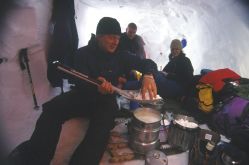
See more about our snow hole expedition!
Andy Bateman a qualified Winter Mountain Leader of 20yrs experience gives his winter gear thoughts relative to the forecast for the Cairngorms Fri 27 Oct – Thu 2 Nov, 2017.
We are now approaching the end of October and the first bout of proper wintry weather has swept across our hills. There should be another one later this week.
Up to this point, there has been a notable lack of frosts so the ground is going to be relatively warm. Forecast precipitation doesn’t look as if it is going to amount to much. It looks unlikely you will be facing full on conditions. Having said this they are predicting high winds, blizzards and a wind-chill down to -10 deg C for the highest tops so it’s most definitely time to review the kit in your rucksack.
It’s worth noting also: a forecast is only a forecast. Things can change and so in turn can my thoughts below. It is of course imperative that an updated forecast is sort on the evening or morning prior to setting out.
At this point in time the crampons are unlikely to be much benefit. They might make it into the boot of the car just in case but there could well be a chance of fresh dusting of lying snow so proper winter boots are most definitely a consideration (B2 or B3). Where you have the ground covered in a thin layer of fresh snow stiff winter boots rather flexible boot with a flexible crampon would be the most likely the preferred choice.
Although no substitute for proper crampon in full winter conditions in these conditions [amazon_textlink asin=’B0172G4S7U’ text=’Kahtoola microspikes’ template=’ProductLink’ store=’1603-8102-0783′ marketplace=’UK’ link_id=’e836781c-bd95-11e7-b79a-19be9ad20467′] might be an idea.
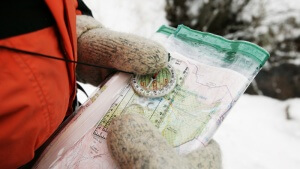 Winter walking in the Cairngorm Mountains, Aviemore, Scotland.
Winter walking in the Cairngorm Mountains, Aviemore, Scotland. As is the case at any time of the year but especially now, the body is likely to chill pretty quickly once you come to a stop. That extra thick fleece or an overlay jacket for when you’re not active most definitely can justify its place in the rucksack now.
Hand could also benefit from gloves being thicker. It’s time to be swapping the summer gloves for the winter ones. Another thing to bear in mind is to make sure the rest of your body is adequately insulated. If your torso is warm you will be far more resistant to getting cold hands. Think how the body conserves the core temperature – it restricts the circulation to the extremities e.g. hands. Often folks say it’s just their hands that feel cold and only deal with the affected area. You torso won’t feel cold because the body has compensated but that’s not to say hands won’t benefit from an added layer to the torso.
Warmer leg ware is also a consideration. It might be a case of wearing leggings/long johns
To state the obvious, eyesight is vitally import in the mountains. Trying to navigate directly into a blizzard can be at best purgatory, at worst nigh impossible. Even relatively light winds can cause snow to hit you directly on the eye ball. It’s not nice. In our damp cold mountain climate condensation is an issue so make sure you equip yourself with some proper anti fog (double lenses) ski goggles. A pair of safety goggles out of a workshop just doesn’t ‘cut the mustard’.
You of course you should be carrying these at any time of the year but now you maybe wearing them for their windproof as much as their waterproof qualities. A jacket with an integral hood is also a must.
It’s now getting dark at around 5:30pm and the clocks are about to go back. The days are now a lot shorter than they were a few months ago. Possibly an earlier start and less ambitious plans are the order of the hill day but most certainly a head torch with fresh batteries should be part of your kit. It should also be one that’s strong enough to navigate in the dark. A powerful beam makes a massive difference.
If I’m not taking proper crampons I may well at least be thinking about having at least one axe in the party just in case. The forecast is for 2 periods of sub-zero temperatures both lasting around 24hrs so there could be some ice build up where there is seepage emerging from the ground.
We hope to see you out in the hills soon getting ready for the full on winter conditions. If you’re signed up for our newsletter you’ll shortly be invited to join us to bring in the New Year. See you then – hopefully with plenty of the white stuff on the hill!
We run winter skills courses and winter walking holidays in the Cairngorms and across Scotland. We are also specialists in winter expeditions, especially the snowhole. Please see our video below to entice you to join us … some dates only limited availability.
One of our reasons for moving to the Cairngorms was that we knew we would experience a “proper” winter i.e. snow. None of this wet and slightly cool weather which seems to characterise winter in the London area. No we wanted proper snow. That white stuff which seems to terrorise the rail network and bring London to a grinding halt. Here in the Highlands it can be something to be enjoyed. Fortunately there are others who are of the same mindset as us and look forward to a proper winter season so they can dust off their skis or crampons or snowboards.
Plenty of winter fun to be had here in the Cairngorms. Here’s just a small selection of activities you could enjoy:
Sonja, Cormac and Katie came to visit Fraoch Lodge Dec 2012 to early New Year 2013. Cormac was booked on our Hogmanay Winter Skills trip as a treat for his significant birthday; which left Sonja and Katie to fill the week with their own activities. They managed to keep themselves very well occupied for the week. Katie even tried to roll her own pasta one evening. She was very pleased – so much more to report back to her friends than she expected.
Sonja kindly agreed to write up their adventures here:
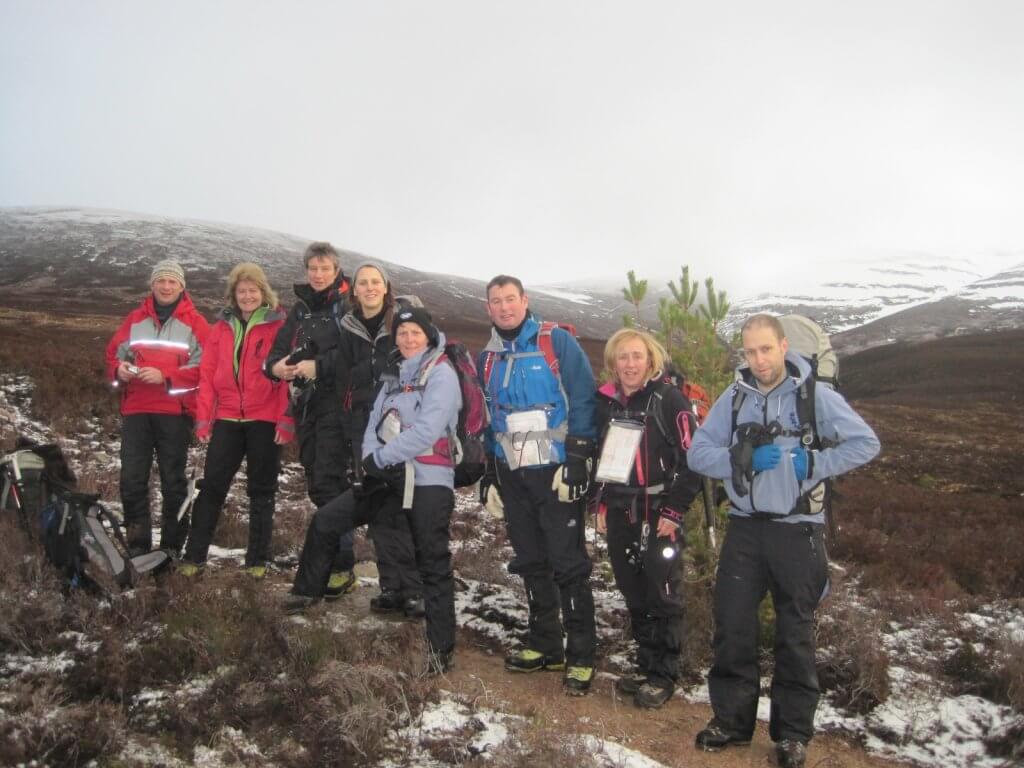
Navigating on New Year’s Day
Cormac’s big birthday was fast approaching and I had no clue what I was going to do. He is an avid hillwalker and mountaineer so I felt something in Scotland might be a good plan. We spend quite a bit of time in the Glencoe area so I wanted to try somewhere new. The Cairngorms National Park seemed the obvious choice. I had spotted Fraoch Lodge while surfing ‘the net’. The idea of a Winter skills courses combined with freshly made homemade bread appealed to me straight away.
I enquired online, then Andy (one of the proprietors) responded to me straight away. He answered all my queries and came back with an excellent price for two adults and a child for a week’s stay with a course included.
So Cormac would be yomping around the Cairngorms for the week, digging snow-holes and cutting steps etc. Now what to do with a nine year old adventuresome type girl?
We decided a spot of snowboarding would be just the ticket.
We set off for Scotland early on the 27th of December and caught a ferry from Belfast to Stranraer. Our drive was scenic but uneventful. Upon arrival at Fraoch Lodge, wee Gregor, a roaring fire and tea and cake greeted us. This was all very, very welcome after a 12 hour journey in the car. Each afternoon we would enjoy a variety of cakes in front of the fire. This quickly became my favourite part of the day.
Soon the rest of the Hogmanay group arrived. We all met in the dining room for a hearty two-course dinner with our hosts. Plans were made for the next day and most of us retired to bed or the cosy warmth of the sitting room. Our rooms were great, clean, comfortable and warm, which just added to our sense of being in a home from home.
The next morning dawned bright and clear. Katy (the adventurous nine year old) and I, set out for Aviemore to the local tourist office to find out what was available to us in the area. We were unable to go snowboarding due to the gusting winds up at the piste.
We met a really delightful man in the tourist office who was courtesy and friendliness itself. He gave us a number of pamphlets and outlined so many things that were on offer in the area. We booked tickets for the wildlife park the next day. That day followed its usual pattern of delicious cake, hearty grub and interesting and fun conversation with the other guests.
The next day, packed lunch in hand, we set off to The Highland Wildlife Park. We had never seen such an array of exotic animals before from Polar Bears to Bactrian Camels and everything in between. The park is a wonderful day out with so much to see and great talks at feeding time. Katy thoroughly enjoyed herself and we had no trouble whiling away an entire day there.
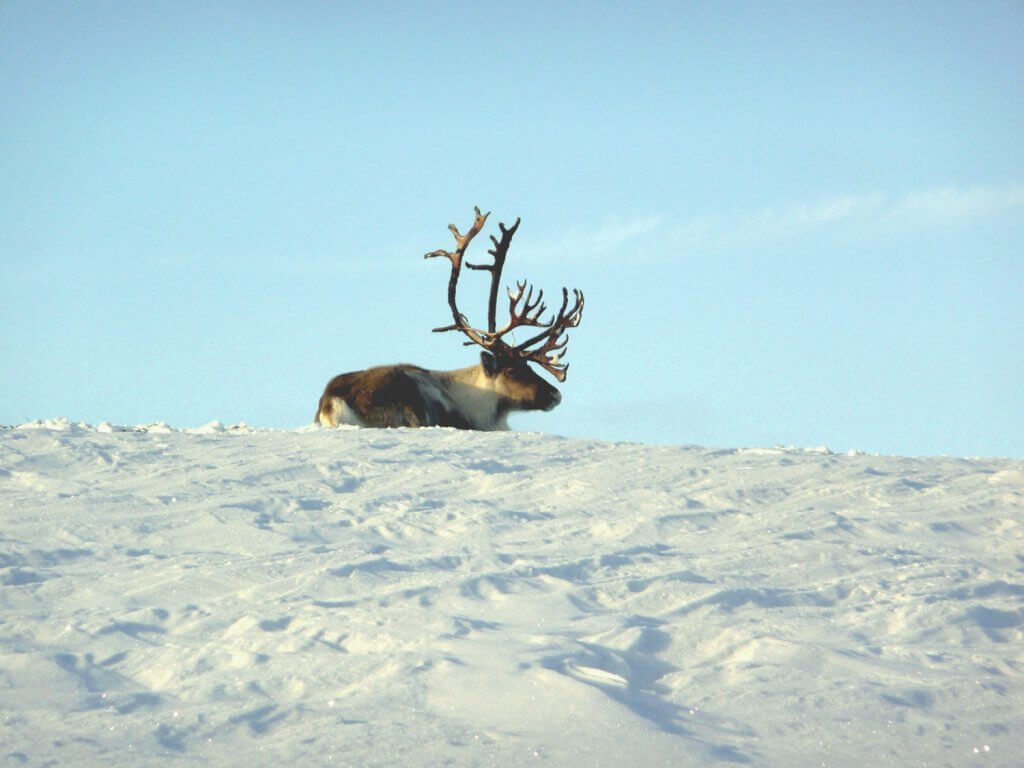
Always a memorable site – the Cairngorm Reindeer herd
The next day the winds continued to stymie our snowy plans so we headed up to The Cairngorm Reindeer Centre. I think this was one of Katy’s favourite activities.
We went out to the little paddock set off to the side of the centre and saw a number of reindeer but the real treat was to come. Everyone followed the staff up in convoy to a car park someways up the mountain. We hopped out and were given a brief talk (it was chilly) about the plan and off we set. We went down a winding trail to a beautiful river, across the wooden bridge and up the other side. This lead us into the foothills of the Cairngorms. Soon we were surrounded by a herd of 200 reindeer all looking for attention and of course the food pellets that they knew we had.
It was a wonder to see these majestic creatures up so close, particularly after the long hard Christmas they had just had. They seemed to be enjoying their well deserved break from their North Pole duties!
That evening I was really touched to see that Rebecca had gone to a lot of trouble for Cormac’s birthday. She had prepared his favourite chocolate biscuit cake (with candles) for cake o’clock and put up birthday banners in the dining room.
The next day, still unable to snowboard, we hit Aviemore. We treated ourselves to big steamy cups of hot chocolate and a spot of sledding in the town. We planned to go dog sledding the next day so we relished the idea of a relatively easy day spent at home in front of the fire.
The next day we set off for The Cairngorm Dog Sled Centre. This again was easily one of Katy’s favourite experiences. After a long talk by the owner of the centre who is a real character and very passionate about his dogs we set out on a motorized vehicle that was ‘pulled’ by a team of sled dogs. It was exhilarating and we loved every minute of this activity.
We spotted a huge stag watching us, as we flew past him with the dogs running as though their lives depended upon it. My only advice for anyone planning on partaking in this activity: bring a lot of very warm clothes.
That night, after a feed of Haggis, tatties and neeps, we set out for the local Ceilidh with the rest of the guests from the Lodge We had a really wonderful night of dancing. Katy came with us and managed to ‘Auld Lang Syne’ her way into the New Year but we retired home moments after the clock struck twelve. She was all danced out.
On our last day Katy was feeling a little under the weather so she, wee Gregor and I had a duvet day. We spent the day lazing in front of the fire wrapped up in sleeping bags, drinking hot chocolate and eating cake. A perfect ending to a wonderful week in the Cairngorms.
I have absolutely no hesitation in saying that I will return to Fraoch Lodge to spend more time in that lovely part of the world. We barely touched the surface with regard to what can be done in the area. We still haven’t snowboarded there so that will need to be experienced. In fact I plan on doing the snow-holing weekend with the expert himself, Mr Bateman and the Winter Skills is also on my wishlist. Can’t wait!
For the full range of walking holidays and skills courses offered by Scot Mountain Holidays please check here.
So you’re considering going on a hiking holiday? Firstly; great choice. Not only is hiking extremely beneficial to your health and wellbeing. But it’s also a cheaper way to travel and allows you to experience the essence of a place. Hiking holidays are becoming increasingly popular, but there is the question, how to choose a hike in Scotland when there’s such a wide range available?
The first thing to consider is if you want to go on a hike or a walk.
Do you want or need a guide? Fortunately, Scot Mountain Holidays have a range of group hiking holidays, tailor made tours, and private guiding options available, so you’ll definitely find the right hike for you. But to ensure you’ve found the perfect hike you do need to consider certain aspects.
Are you intending to go on an inn-to-inn hike? Follow a long distance trail? Or do you want to get into the mountain wilderness areas and have a truly unique and off the beaten track experience?
Are you quite happy hiking on your own but you’d like some guidance on choosing routes, support with transport? Find out about Scot Mountain Holidays self-guided options for the more adventurous.
Tours with Scot Mountain Holidays range from weekend getaways to seven days long. With tours running throughout the year, all that is required is for you to decide on your availability.
Choosing a season is one of the most important decisions in finding the right hike for you. Spring and summer are the most popular hiking periods and also provide the most pleasant hiking conditions. Perfect for those with families or first time hikers. Autumn is a wonderful season for hiking due to the beautiful colours, the changing environment and lack of climbing traffic. Autumn is suitable for everyone, and ideal for those who prefer a cooler temperature. Winter is considerably more difficult to hike in, and we recommend winter hiking for those confident in their abilities. This is due to the additional gear required and the added challenges of often hiking through snow. Winter is however often a more rewarding experience, with the raw beautiful scenery, clear winter views and the satisfying sense of accomplishment.
Scot Mountain Holiday tours are graded on a level of difficulty from two to five, with five being the most difficult. When considering how to choose a hike in Scotland it’s important to take into account your own level of fitness and choose a tour suited to you. For an overview, refer to the Scot Mountain Holidays grading system.
All Scot Mountain Holidays tours are all inclusive. So, all you need to do now, is chose a hike. To ensure the experience pre, during and post hike is completed stress free for you, Scot Mountain Holidays will take care of the rest.
Narrowing down the destination for your yearly holiday can be difficult. Trying to decide between relaxation and adventure often leaves you straddling the fence. And factoring in whether you’re approach should be take it as it comes or plan ahead so you have a full day of activities can often be exhausting. So that leaves the question, what is a winning holiday formula?
Here at Scot Mountain Holidays we think adding a little of everything creates the perfect recipe. The best of both worlds, if you will. Our perfect formula incorporates relaxation time and adventure. Amazing food, but cooked in the homely style that makes you feel like you’re home away from home. And finally, the kind of holiday where you have plenty to do, but don’t have to plan or think about any of it.
Our fully catered walking, hiking or cycling holidays means there is no stress on you. Not only does it allow you to experience parts of Scotland not often seen and get really under the skin both culturally and historically. But you’ll also have the perfect balance of adventurous activity and down time. Based from the Cairngorms National Park, Fraoch Lodge, run by Scot Mountain Holidays, is the perfect base for your holiday. The national park will give you opportunity for serene country strolls, stunning views and quiet afternoons by the fire. And the guided tours will satisfy all your adventure needs with the added bonus of activity (hiking and/or mountain biking for the most part, though other options are available) and breathtaking scenery. Incorporate restaurant quality food served in a homely style we all love and you’ve got yourself the perfect holiday.
So take away the stress of planning and booking your holiday. Scotland no matter what the season is an incredible destination. And if you book with Scot Mountain Holidays, you really will have a winning holiday formula.
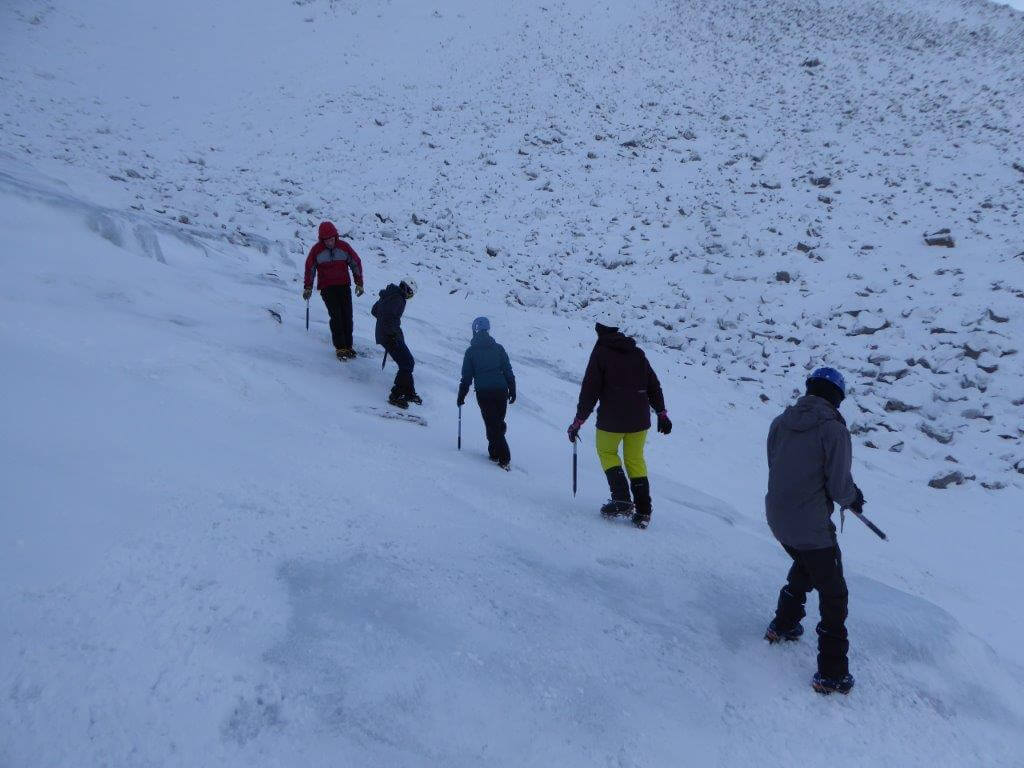
It’s now middle of November and winter in our mountains is knocking at our door. As the Atlantic storms pass our area the arctic air is drawn into their wake. With each passing front, the weather can be extremely changeable. It may be weeks yet before winter conditions are in full nick for full on winter walking, but sudden blizzards on the high tops are now common place – meaning the ill prepared can be easily caught out. Scot Mountain Holidays guide and instructor Andy Bateman takes us through some of the considerations over and above the essentials of ice axe and crampons in transitioning from autumn in winter trekking conditions.
It is prudent to carry a head torch at most times of year, but especially in the case of winter. The days are short and even a minor delay can make the difference between coming off the hill in the daylight and dark. Don’t go without!
In addition, make sure the batteries are fresh so your torch is working at full power. Carry spares too but try to avoid fumbling about to change batteries in a blizzard!
Consider upgrading your head torch to a more powerful model . Remember you may be trying to discern navigational features both in the dark and in the fog.
The stiffness of the winter boot is an integral part of ensuring crampons can be securely attached to your feet. This being said, bunging crampons is not a “fix all” and the winter boot is as much a tool on your foot as the ice axe is in your hand. You need adequate stiffness to kick steps comfortably and efficiently into hard snow. Without it, it will be difficult to execute the technique of front pointing safely.
Proper winter boots are also better insulated. If you’re thinking about buying a boot for the winter go for at least a B2. A B1 boot may be fine for a serious summer glacier trek in the Himalayas, but they don’t come up to the mark when it comes to winter in the Scottish mountains.
Check the state of your soles. It’s those sharp right angled edges that help to prevent slipping and allow you to kick steps.

Which boots to choose for winter?
These are an absolute must and in our damp mountain climate they need to be anti-fog (double lenses). It may be uncomfortable – but not impossible – navigating into driving rain, but don’t underestimate how painful this is once precipitation turns solid. It can be literally impossible to see. Your sight is of vital importance so don’t skimp on the goggles and head torch.
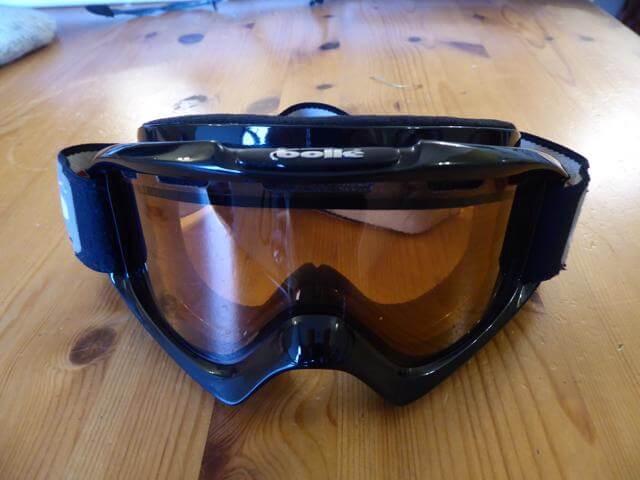
Pack that extra warm layer. The ambient temperature at 1000m rarely drops below -10 degrees C but don’t underestimate how cold it can feel. A weak winter sun, the damp air and often a high wind chill all conspire to make the British mountains one of the worst places for hypothermia. You can chill quickly when you stop moving. A really thick fleece or over layering jacket is ideal. Be cautious about wearing duvets jackets under other garments – they can loose their loft and hence insulation.
Make sure you gloves are warm enough for winter walking … i.e. they must be proper thick gloves. Not only do your hands have a very large surface area compared with their volume but also the body will reduce the circulation to them to conserve the core temperature – no wonder they get cold! So if you do have cold hands don’t just think of putting on warmer gloves, but also an extra layer on your body.
Also remember if you do particularly suffer from cold hands, mitts are better at giving you the option of adding heat pads.
If you’re coming on a winter skills course or winter walking holiday with Scot Mountain Holidays please don’t hesitate to contact Andy if you have any further questions, an expert in optimal gear.
Andy will be publishing further blogs on the subject of preparing for winter over the forthcoming weeks. Keep your eyes open!
You can also take a look at our Winter walking holidays, Winter Skills courses and Full moon Snow-hole Expedition.
With more and more evidence surfacing of the adaptability, quality and craftsmanship of Scottish textiles manufacturers catching on worldwide in fashion luxury goods and film, it is no surprise the industry has also taken on sport technology.
Performance in a fabric is crucial to hikers, walkers and cyclists. In Scotland, weather can change so frequently that when it comes to treks off the beaten track (a speciality of Scot Mountain Holidays), to quote Duracel, “it just has to work”.
But we believe gear should more than work. It should be comfortable and enhance your experience. We also believe in supporting local and regional manufacturers for economic and environmental purposes.
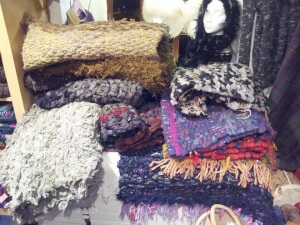 Using the edge trimmings from the looms to make rugs. All made from 100% wool as is tweed. Wool is coming back in to fashion in outdoor clothing.
Using the edge trimmings from the looms to make rugs. All made from 100% wool as is tweed. Wool is coming back in to fashion in outdoor clothing.For these reasons, we have tracked down 5 Scottish innovators in the textile sport industry who are completely changing the performance game.
1. Findra
Dubbed by SCI market research as one of the top sport textile innovations in the last five years, Findra creates mountain biking clothing especially for women. They are recognized for their seamless knitting technology and unique textiles.
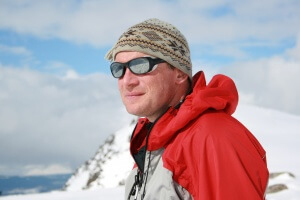 Andy in a Nikwax Analogy smock jacket by Páramo
Andy in a Nikwax Analogy smock jacket by PáramoWhile Nikwax was developed in Northern England, innovater Nick Brown accredits his many walking holidays in Scotland as the inspiration for the product – so we feel it fits nicely on our list. This elastic and water-repellent treatment makes performance clothing elastic and breathable, protecting you from inevitable Scotland rain.
From the Commonwealth Games to other professional sporting events, Harris Tweed is a becoming a feature of athletes all over the globe as they are revered for combining style with performance.
4. Diary Doll
Another product innovation for women. Lightweight with a waterproof panel, these machine washable pants give women the freedom to carry on their explorations stress free.
5. Bonar Yarns
‘Greatness is in the detail’. This Scottish manufacturer has forever changed the notion of turf, enhancing sporting events all over the world.
Here in the Cairngorms we are part of the Highland way of life and keen nature enthusiasts, meaning we must be ready to adapt to Scotland weather in pursuing our adventures.
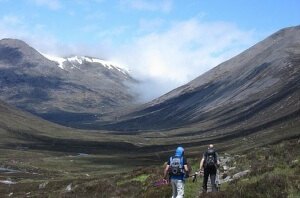 Self-guided Lairig Ghru Logistics
Self-guided Lairig Ghru LogisticsWith manufacturers like these, nothing can hold us back!

In February we ran a snow hole expedition, the second of the year, in the Cairngorms.
The group was small but unusual.
Ian – our most frequent flier on the snow hole. This was his third snow hole trip. Ian first joined us in 2006 to attempt an overnight snow hole in the Cairngorms National park. The weather was against them on that trip and they had to turn back without reaching the snow hole site. The ski area wasn’t open and though the group attempted to ascend the hill they eventually had to turn back after being blown around a wee bit too much. There is video footage from their endeavours which makes for interesting viewing just to see the effect of nature, if nothing else. Ian returned again in 2007 with 90% of his group to try again – successfully
Andy – our oldest client to date on this trip – a celebration of his imminent 70th birthday.
Hui – our first guest from Singapore. A lone female traveller spending a few months in the UK on a sabbatical from her studies.
Read all about their experience in Andy’s words:

Late last year whilst at David Lloyd’s (gym), I said to my friend, Ian Thorpe, an experienced walker and climber, that I fancied carrying out some serious winter walking, but not climbing. Ian replied “Let me take you to the Cairngorms National Park, Scotland.” This was duly arranged by ian and off we set on 21st February at 10am, arriving at Fraoch Lodge in Boat of Garten, in the Cairngorms, at 16.15.
Rebecca, Andy and wee Gregor made us extremely welcome; dinner was baked salmon with a rich and wonderful sauce, followed by home made trifle containing shortbread and blackcurrants, wonderful.
Next morning, along with fellow trekker, Hui, a lady lone traveller from Singapore, we were fitted out with ice axe, crampons & helmets prior to spending our first day on the mountains practising ice axe arrest. This was a daunting experience for some one who has never even worn crampons let alone walked on ice.
Later that day we walked till late on Lurcher’s Crag and the Chalamain Gap, looking towards Corrie an Lochain, before returning to Fraoch Lodge for another wonderful dinner, having first stocked up on copious bottles of red and white wine from the local Tesco.
On Saturday 23rd February after a hearty breakfast at 7.30, we set off for the snow hole day. We arrived at Aviemore ski resort and walked in. At about 2pm we were ready to dig our snow hole. Andrew marked out 2 doorways on the ice covered mountain side. (We were about 3000ft up by now.) These door holes, roughly about 12ft apart, were then dug into using ice saws and snow shoverls. It took 2 hours to create a vertical face, then we had to further excavate in for about 5ft prior to turning inwards to join the 2 ends of the snow hole. This was particularly backbreaking work for Hui, thank God we had clear blue skies and sunshine. After about 4 more hours, the hole was completed. My feet were so cold I could hardly feel them.
Having put all our gear, including cooking utensils inside, Andrew started the evening meal. We had hot tea, followed by carrot and coriander soup, then a buckwheat and chorizo casserole. Dinner commenced about 10.30pm! Ouside the temperature was approx -9oC; inside however was relatively comfortable.

Stunning views from the “window” of your overnight accommodation deep in the heart of the Cairngorms
Next morning we woke up to a complete whiteout. My fear was how do we navigate to the summit of Cairngorm Mountain? Andrew explained that we take a direct compass bearing but because I was finding the walk hard he explained that provided we walked clearly up and around the pudding shaped mountain, we would by definition reach the summit and incidentally GB’s highest automatic weather station. After approx. 600m of ascent we duly found the summit at 1245m.
Roughly 4 hours later, we had descended back to the ski lodge. It was particularly hard going with Hui hanging on the to back of Ian’s rucksack most of the way. We had the pleasure of seeing a Ptarmigan and 2 white hares.
Overall a fabulour experience which I will not be repeating, but one to tick off. Andrew’s knowledge of the terrain, geology, weather conditions, and navigation skills were par excellence.
Having successfully returned to Fraoch Lodge, we were treated once again to an excellent farewell dinner. Many thanks Ian, Andrew and Rebecca for a memorable trip which i will not forget for a long time.
Andrew Palliser
PS My 70th Birthday on March 12th 2013 – what a perferct birthday treat to myself!

Many gear shops will automatically sell you a leash as an essential and permanent accompaniment to your ice axe. Here we look at the pro’s and con’s of having a leash on your walking/general mountaineering axe. We discuss when and where it is appropriate to use one.
There is at least one recorded instance where loosing grip of the axe during a sliding fall resulted in head injuries due to the axe flailing uncontrollably at the end of a leash. Rather than relying on a leash to retain possession of your axe, the emphasis is on instilling the mental capacity of not letting go. The hand holding the head of the axe can pivot around the head but the grasp should remain the same. It’s also about developing that mental ability of properly securing your axe should you need to put it down.
Except when cutting steps down slope, you should always carry the axe in the up hill hand. On a zig-zag ascent or descent, the axe is repeatedly swapped from one hand to the other to maintain it in the uphill hand. Having to swap the leash from one wrist at every turn is cumbersome and time consuming. Wrapping the leash around the head of the axe isn’t a secure solution either. There is the risk it can start to dangle with resultant hazard of a crampon point catching and causing a trip.

Photo caption: cutting steps in the Cairngorms on a winter skills course with Scot Mountain Holidays
This is where a leash is desirable especially if you are cutting into hard snow or ice. Wet gloves, cutting the steps too vigorously, etc can all increase the chance of loosing grasp and this is where a leash comes into its own.
For winter hill walking, a leash should be minimalist, light weight and quickly attached and detached from the head of the axe. The simplest way is to make a loop in the attachment end of the leash. Thread the loop though the hole in the head of the axe. The other end of the leash is then threaded through the loop (Larks footed) and pulled tight. Store the leash in an easily accessible place like a jacket pocket and attached to the head of the axe when required.
Have fun in the snow: http://www.wikihow.com/Have-Fun-in-the-Snow
Snow related activities for kids: http://www.parents.com/fun/activities/outdoor/snow-activities-kids/#page=7
Family fun in the snow: http://powertochange.com/family/snow/
Free mountain weather service: Mountain Weather Information Service
Met Office forecast for the hills: Met Office Mountain Forecast
Scottish Avalanche Information service: Scottish Avalanche Information Service
How to ice axe arrest: https://scotmountainholidays.com/blog/skills-how-ice-axe-arrest/
Best practice: how to build a snow hole in Scotland: https://scotmountainholidays.com/blog/best-practice-building-snow-hole-scotland/
How not to get lost – the art of navigation: https://scotmountainholidays.com/blog/hiking-how-not-get-lost-art-navigation/
Top 10 winter skills tips (for Scotland): https://scotmountainholidays.com/blog/top-10-winter-skills-tips/
How to prepare for a mountain challenge: https://scotmountainholidays.com/blog/classic-ridges-and-horseshoes-hiking-tips/
Which boots to choose for winter: https://scotmountainholidays.com/blog/which-boots-choose-winter-walking/
How to choose a walking ice axe: https://scotmountainholidays.com/blog/how-choose-walking-ice-axe/
How to predict snow: https://scotmountainholidays.com/blog/how-predict-snow-uk/
EXPEDITIONS FROM SCOT MOUNTAIN HOLIDAYS: https://scotmountainholidays.com/activities/mountain-challenges/
SKILLS COURSES FROM SCOT MOUNTAIN HOLIDAYS: https://scotmountainholidays.com/activities/mountain-skills-courses/
WINTER WALKING HOLIDAYS FROM SCOT MOUNTAIN HOLIDAYS: https://scotmountainholidays.com/activities/walking-holidays-uk/
All content © Copyright Scot Mountain Holidays 2025
Responsive web design by Summit Web Solutions